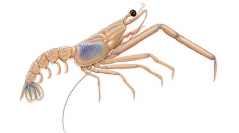

 Geodiversitas
34 (3) - Pages 531-568
Geodiversitas
34 (3) - Pages 531-568The Oxfordian fauna from the Terrain à Chailles Formation, eastern France (Haute-Saône, Franche-Comté) is remarkable for its exceptionally preserved crustaceans found in siliceous concretions locally named “chailles”. The crustacean fauna includes 9 different species assigned to the Glypheidae, the Erymidae, the Eryonidae and the Axiidae. Glypheid and erymid lobsters are the most diversified groups with four and three different species respectively. Re-examination of numerous new specimens allows to a more modern and more complete characterization of Glyphea regleyana (Desmarest, 1822), Glyphea muensteri von Meyer, 1840 and Eryma ventrosa (von Meyer, 1835). New detailed anatomic descriptions of these species highlight the presence of marked sexual dimorphism in G. regleyana and probably in E. ventrosa. They reveal processes of autotomy and phenomena of ecdysis in G. regleyana, E. ventrosa and G. muensteri. Quantitative analyses based on 424 nodules show three dominant species: 1) Glyphea regleyana (50.5% of nodules); 2) Eryma ventrosa (24.8%); and 3) Glyphea muensteri (16.5%). Convergent lines of evidence from depositional environment, comparisons with others Jurassic crustaceans and modern analogues indicate that the crustacean fauna from the Terrain à Chailles Formation probably inhabited a moderately deep water setting most probably about 100-150 m (lower circalittoral zone) where light intensity was even sensitive. These crustaceans constitute a very original assemblage intermediary between the communities from the shallow carbonate platforms (e.g., Solnhofen) and those from the bathyal zone (e.g., La Voulte). This new set of data sheds new light on the colonization of the distal platforms by crustacean communities in the Mesozoic.
Crustacea, Decapoda, Glyphea, Eryma, exceptional preservation, nodules, chailles, Haute-Saône, Franche-Comté, Late Jurassic